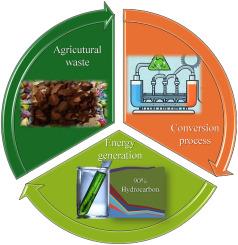可可豆壳热解生产可再生燃料的催化剂评价
IF 5.8
2区 生物学
Q1 AGRICULTURAL ENGINEERING
引用次数: 0
摘要
对气候变化日益增长的担忧正在推动可再生能源技术的探索,以取代化石燃料,其中热解过程成为一个有前途的解决方案。然而,这种热化学过程的效率需要提高,主要是关于其产品的质量。为了探索改进这一替代方案,本研究研究了四种不同催化剂(沸石HZSM-5、水滑石(HTC)、Ni- re /Nb2O5和Ni/Nb2O5)在氦气氛下对可可豆壳进行分析热解的应用。热解实验分为催化剂类型、温度和催化剂配比三个阶段。所有四种催化剂在550°C下以催化剂与生物质(C:B)的比例为3:1进行评估,与在产生含氧化合物普遍存在的异质产物的纯生物质上进行的测试相比,显示出减少含氧化合物的能力。然而,铌基催化剂将含氧化合物转化为含氮化合物,主要是长链腈,占Ni/Nb2O5的24%。HTC和HZSM-5在450、650和750°C下的进一步测试表明,HTC的结果在更高的温度下得到了改善,在750°C下产生了43%的碳氢化合物。由于HZSM 5催化剂被证明效率更高,在产品组成中碳氢化合物的含量达到70%左右,因此选择它进行最后阶段的实验,在550和750°C下进行,C:B比为1:1和5:1。综上所述,HZSM-5在提高热解产物质量的同时表现出较好的低温效率。在550°C时获得最佳结果,其中90%的化合物为碳氢化合物,其中82%为芳香族。本文章由计算机程序翻译,如有差异,请以英文原文为准。

Catalyst evaluation for renewable fuels production from cocoa bean shell pyrolysis
Growing concerns about Climate Change are driving the exploration of renewable technologies to replace fossil fuels, of which the pyrolysis process emerges as a promising solution. However, the efficiency of this thermochemical process requires enhancement, primarily concerning the quality of its products. To explore into improving this alternative, this study investigates the application of four different catalysts (zeolite HZSM-5, hydrotalcite (HTC), Ni-Re/Nb2O5 and Ni/Nb2O5) employing analytical pyrolysis of cocoa bean shells under helium atmosphere. The pyrolysis experiments involved three stages assessing the effects of: catalyst type, temperature and catalyst proportion. All four catalysts, evaluated at 550 °C with a catalyst-to-biomass (C:B) proportion of 3:1, displayed the ability to reduce oxygenated compounds when compared to the tests conducted on pure biomass that generated heterogeneous products with a prevalence of oxygenated compounds. However, niobium-based catalysts converted oxygenated into nitrogenated compounds, mainly long-chain nitriles, constituting 24 % with Ni/Nb2O5. Further tests with HTC and HZSM-5 at 450, 650, and 750 °C revealed that HTC's results improved at higher temperatures, producing 43 % of hydrocarbons at 750 °C. As the HZSM 5 catalyst proved to be more efficient, achieving values around 70 % of hydrocarbons in the product composition, it was selected for the final stage of experiments, conducted at 550 and 750 °C, with C:B ratios of 1:1 and 5:1. In conclusion, HZSM-5 exhibited satisfactory results for enhancing the pyrolytic products quality while also demonstrating low-temperature efficiency. Best results were achieved at 550 °C, where 90 % of the compounds were hydrocarbons, of which 82 % were aromatic.
求助全文
通过发布文献求助,成功后即可免费获取论文全文。
去求助
来源期刊

Biomass & Bioenergy
工程技术-能源与燃料
CiteScore
11.50
自引率
3.30%
发文量
258
审稿时长
60 days
期刊介绍:
Biomass & Bioenergy is an international journal publishing original research papers and short communications, review articles and case studies on biological resources, chemical and biological processes, and biomass products for new renewable sources of energy and materials.
The scope of the journal extends to the environmental, management and economic aspects of biomass and bioenergy.
Key areas covered by the journal:
• Biomass: sources, energy crop production processes, genetic improvements, composition. Please note that research on these biomass subjects must be linked directly to bioenergy generation.
• Biological Residues: residues/rests from agricultural production, forestry and plantations (palm, sugar etc), processing industries, and municipal sources (MSW). Papers on the use of biomass residues through innovative processes/technological novelty and/or consideration of feedstock/system sustainability (or unsustainability) are welcomed. However waste treatment processes and pollution control or mitigation which are only tangentially related to bioenergy are not in the scope of the journal, as they are more suited to publications in the environmental arena. Papers that describe conventional waste streams (ie well described in existing literature) that do not empirically address ''new'' added value from the process are not suitable for submission to the journal.
• Bioenergy Processes: fermentations, thermochemical conversions, liquid and gaseous fuels, and petrochemical substitutes
• Bioenergy Utilization: direct combustion, gasification, electricity production, chemical processes, and by-product remediation
• Biomass and the Environment: carbon cycle, the net energy efficiency of bioenergy systems, assessment of sustainability, and biodiversity issues.
 求助内容:
求助内容: 应助结果提醒方式:
应助结果提醒方式:


